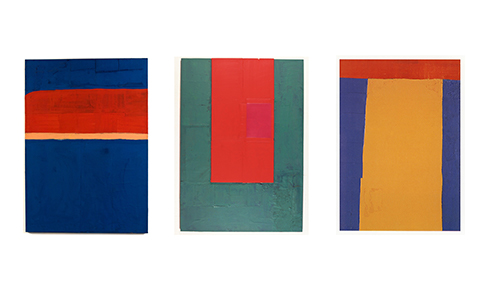1989
Lorenzo Mammi
Galeria Millan
Some time ago Renata Tassinari used to paste small objects (nails, rulers etc) on the canvas to cover them afterwards with a uniform paint in wide monochromatic extensions. Over time, these objects disappeared. However, some surface restlesness and irregularity was kept by overlapping newspaper sheets, cardboard, and wood strips. Accordingly, the painting got denser and more compact due to the change of material, from oil paint to acrid wax. Surface and color are still the focus of Renata Tassinari ´s research, but now these elements are present in a more essential way and their relation is more tranparent.
Color is, without question, the strongest atraction point that takes over the center of the canvas. The way it spreads in big, juxtaposed areas hint at a cool, extremely slow rhythm. It is precisely this rhythm together with irregular, different (and ever-present) relation with the support that suggests a static and isolated contemplation of each color area, like a simple presentation of sensitive quality and not as a function of the composition. In other words, colors are not so much closely related as they establish a vertical relation, point by point, with the canvas surface they cover. Like a map, the color presents itself more like a feature of an area than like a part of a drawing.
Both systems (one laid out by the uneven plan and the other limited by colored squares) reinforce themselves reciprocately in a spiral movement: the surface, different at all times, makes the look upon the painting slowlier and enhances the perception of color as intrinsic quality instead of a simple relation. On the other hand the color can dare, taking on bold, almost "pop" hues because the surface restraint stimulates discussion about its brightness. That way it is even possible to reverse the image of the map, as the color is the characteristic itself of the area it covers, the quality of this area becomes the quality of the color. The uneveness of the surface takes on the function that is normaly attributed to a mix of pigments in search of the exact hue of the paint: by questioning the chromatic vivaciousness it mists them.
The delay of perception and some viscosity of image are a common trend – though probably not pragmatic - of a considerable number of painters from São Paulo. Renata Tassinari, however, presents a new angle. One does not find a thicker painting here even with the use of dense materials such as wax, the pigment is still essentially of color. There are no projections towards tridimensionality neither stratifying intents – although uneven, the surface remains unique. The act of painting absorbs all contraditions of the material and deceives them without wiping them out, like an action that confers a certain extension to a sensitive quality. There is a note of optmism in these paintings that is not certainly just breezy color brightness. Rather, it is a stake on a substantial homogeneity of what is different and the possibility to control it in a unitary mechanism of vision - a testemony of the possibility of color extension despite the descontinuity of the real painting.
